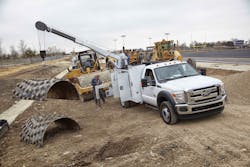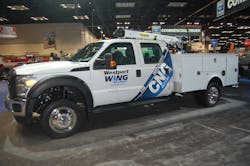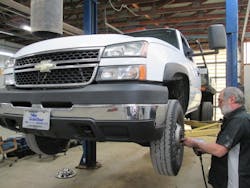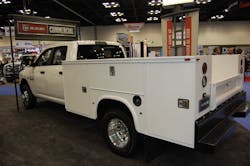Light trucks and vans are undergoing a lot of change these days in an effort to improve fuel efficiency as demanded by the bevy of carbon emissions regulations being issued by both federal and state governments. Yet fleets are not disinterested bystanders in the race for better fuel economy. Saving fuel means saving money on their bottom lines. As a result, changes are now starting to work their way “back,” as it were, from the light truck and van chassis, engines, and transmissions to the many-varied service bodies deployed by working fleets for tackling a wide array of jobs.
George Survant, senior director-fleet management for Time Warner Cable (TWC), illustrates the potential savings service body changes can offer via the recent makeover of TWC’s standard bucket trucks, which are based on Ford’s F-350 and F-450 chassis. “We switched from a steel service body and gasoline power to aluminum or fiberglass bodies mounted on trucks equipped with diesel engines,” he says.
After seven and one-half months of operation, TWC pulled data on 850 of its new bucket trucks —all together, TWC operates 2,895 such units—and compared it to data compiled from trucks equipped with steel bodies and gasoline engines.
“We were pleasantly surprised to find our diesel engine/lighter body spec’d trucks averaged 8.4 mpg, with our older steel body/gasoline engine trucks averaging 5.6 mpg,” notes Survant. “And that’s using just basic off-the-shelf equipment; nothing fancy like compressed natural gas or aerodynamic changes to the service body.”
He points out that TWC plans to put another 380 of its new “lightweight” spec’d bucket trucks into service this year. When added to the 850 such trucks already in service, the fleet expects to save over one-half million gallons of fuel annually.
Craig Bonham, vice president of sales for Reading Truck Body, believes TWC’s experience is just the tip of the proverbial iceberg in terms of the scale of change approaching truck service body design.
“Designs today are being driven by economic, government and customer pressures,” he explains. “Technology is moving so fast, and the race is on to see who can bring what to the market the fastest. Combine that with the need to cheat the weight scale so fuel economy can be maximized and you have an industry that is evolving quickly.”
Mark Reuss, executive vice president of global product development, purchasing and supply chain, General Motors, emphasized in a speech earlier this year that pickup trucks especially are being called upon to do more work. “More than 25% of full-size pickups sold in the U.S. are ‘heavy duties’ or ‘HDs,’ and that added up to about 435,000 trucks in 2012,” he said during remarks made at the North American International Auto Show in Detroit back in February.
“HDs are the workhorses that keep many businesses running year in and year out,” Reuss pointed out. “The average towing weight for HDs is 9,200 lbs., compared to 3,600 lbs. in a light duty, and average HD hauling is 1,800 lbs. —twice as much as a light duty.”
Payload boost
IIncreasing workloads is one reason demand for aluminum bodies is growing, Reading’s Bonham points out, noting that over 42% of the company’s production is now aluminum. He says that fleets are focusing intently on weight reduction so as to acquire chassis with lower gross vehicle weight ratings (GVWR) while still supporting payload requirements.
“Acquiring and operating a chassis with a lower GVWR [results in] lower cost acquisition, operation, service and repair costs,” he points out. “Fleets and companies are also looking to operate vehicles that have a strong focus on reducing noise, vibration and harshness; thus body manufacturers that can present a product that promotes a harmonious marriage between chassis and body create a strong point of consideration in the acquisition process.”
Bonham notes that every 100 lbs. of weight savings equals roughly a 2% efficiency gain for a light truck’s bottom line.
That’s one of the main reasons why Ford Motor Co. is making wider use of aluminum as well as higher-strength yet lighter steel in its 2015 F-150 pickup.
Peter Friedman, manager of Ford’s manufacturing research division, notes the amount of high-strength 70,000 psi steel increased from 23% to 77% for the frame of the 2015 F-150, improving stiffness and durability while saving 60 lbs. in weight.
Ford also is using high-strength, aerospace-grade aluminum alloys throughout the body of the F-150 to improve “dent and ding resistance” and also shave 700 lbs. from the pickup.
“Our objective was to find materials that allowed us to design the truck to be as tough—or tougher—as the current model, yet could help it be hundreds of pounds lighter,” Friedman explains. “Out of all the materials we tested, we carefully selected only certain grades of aluminum that met our high performance standards in all of our tests while allowing us to trim hundreds of pounds from the truck.”
There's still work to do
Reading Truck Body’s Bonham does caution, however, that “you’ve also got to make sure going to a lighter-weight body fits the expected life and work cycle of the vehicle. Aluminum is a 10 million psi metal, but steel is rated at 30 million psi; thus aluminum may need up to three times the reinforcement of steel so it won’t deform under heavy loads. That’s why the use of lightweight materials must always be evaluated with engineering scrutiny to ensure it’s appropriate and job-rated for specific vocational applications.”
That’s one reason why there really haven’t been many significant functional changes in overall pickup box design in more than 50 years, explains Bob Johnson, director of fleet relations for the National Truck Equipment Assn. (NTEA).
“Incremental changes have been made to address appearance or styling issues, manufacturing processes, et cetera, but the basic design has been constant,” he explains. “Some past changes have negatively impacted durability, but in almost all cases, the designs have reverted in favor of durability.”
From this perspective, then, Johnson expects to see the near-term focus on service body changes fall within these areas:
- Lighter truck bodies. Weight reduction is important in some very light-duty applications for compact and half-ton trucks alike, he says. Recent trends in the use of aluminum and various composite materials serve to reduce weight and improve corrosion protection, but weight reduction is, in general, not an issue in three-quarter and one-ton applications.
- Better corrosion protection. Improved corrosion resistance is an important issue in any application where the truck has a usable life of five years or more. The use of aluminum and/or composite materials in the fabrication of a pickup box provides a benefit in this area as long as it does not negatively impact the durability of the completed product.
- Design capability. Commercial truck owners are looking to customize their trucks using available aftermarket components, Johnson notes. These requirements vary significantly from application to application, so it remains important that the design of a pickup box accommodates all of the add-on components available in the aftermarket.
- Storage space. In-cab storage utilizing extended and crew cab models remains a viable feature for pickup trucks in some applications. Storage compartments built into the bed of the truck have been offered in one form or another for many years, but have never proved successful in commercial applications. This is due to a combination of factors that include cost, durability, suitability to specific applications, and the negative impact on the installation of aftermarket components.
Over the next five years, Johnson thinks the main focus will remain on the introduction of improved materials to address weight in under 10,000-lb.-GVWR applications, boosting corrosion resistance and improving manufacturing processes.
“I do not see any significant functional design changes coming in the next five years,” he says. “The largest impact will come in the form of competition from other chassis styles such as the newer van products entering the market. At the commercial acquisition level, price sensitivity and operating cost differentials will drive the market and may erode some of the current market share for Class 2 and 3 commercial pickups or force truck design changes that can reduce acquisition and/or operating costs.”
Price sensitivity
Bonham echoes Johnson’s point on price sensitivity when it comes to work fleets. “Many times the conversation comes down to the price,” Bonham says. “The difference now, though, is the impact still being felt from the Great Recession. That took a lot of customers out of the buying cycle for a few years, and it’s really forced them to take a second look at everything. While price remains critical, total cost of operation is becoming more so, especially as many work fleets want to extend the life of their service bodies by transferring it to a second chassis.”
Bob Raybuck, director of technical services at NTEA, points out that managing the trade-offs will be critical to making lightweighting efforts successful. “All customers want more efficiency and lower cost of operation, but there are trade-offs between higher cost materials and efficiencies gained by using the higher cost components,” he says. “If the new design’s efficiency can offset the additional costs, customers will be interested.”
Raybuck adds that new fuel efficiency standards are driving many decisions on the use of lightweight materials. “Body makers are always interested in providing the most cost-effective efficiencies that help their customers reduce their overall operating costs,” he says.
That need to generate efficiencies is going to convince light truck work fleets to thoroughly re-examine the functionality of their service truck specs, explains Bonham.
“Functionality is more of a focus than ever before [because] products must present a design that is ergonomically friendly and safe to work on, around and inside,” he explains. “It is also clear that customer expectations are that the product will last longer than ever before and present an image that reinforces the name and likeness of the company and the manufacturer.”
Bonham also believes image is everything in the eyes of fleets and business owners; thus service trucks must be finished using world-class materials, processes and procedures.
“This is critical because fleets are keeping [trucks] longer than they ever have before,” he explains. “Of course, technology comes at a price, and that price must be realized through a total cost of ownership analysis that justifies the acquisition.”
About the Author
Sean Kilcarr
Editor in Chief
Sean Kilcarr is a former longtime FleetOwner senior editor who wrote for the publication from 2000 to 2018. He served as editor-in-chief from 2017 to 2018.



